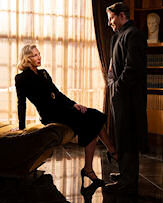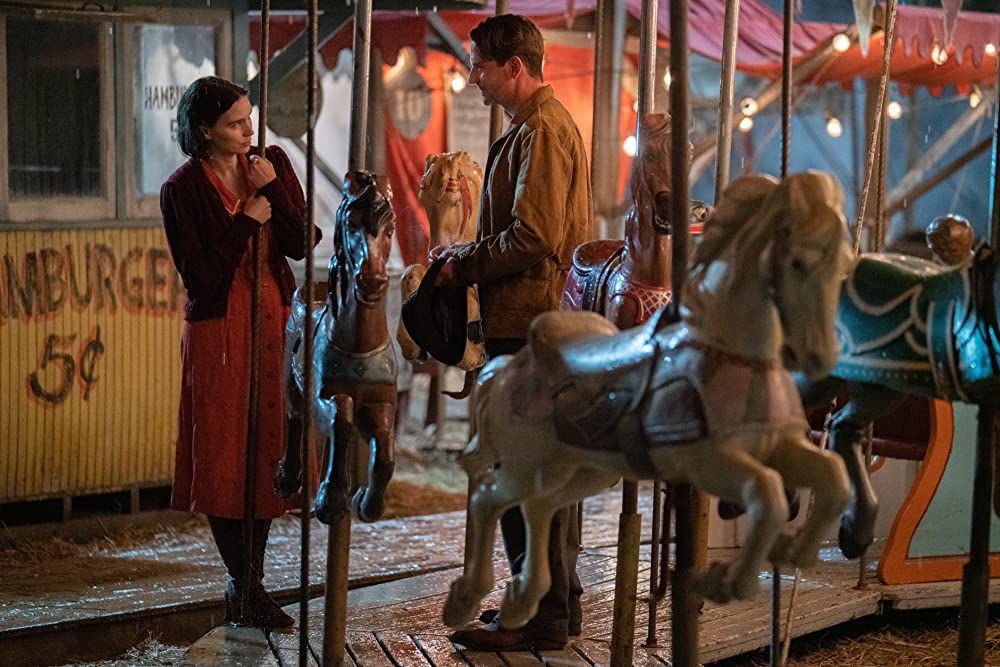 — by WILLIAM STERR —
— by WILLIAM STERR —
“The Shape of Water,” “Crimson Peak,” “Pacific Rim,” “Pan’s Labyrinth,” “Hellboy,” “ Hellboy II,” “Blade II,” “The Devil’s Backbone,” “Mimic,” “Chronos.” Guillermo del Toro – director, writer, imaginist – has had an impressive career over the 24-year span of these films. He is the reigning king of “creature features,” even having scored Best Picture and Best Direction Oscars for “The Shape of Water.”
“Nightmare Alley,” based on the 1946 novel by William Lindsay Gresham, and first made into a 1947 feature starring Tyrone Power in a radical re-direction from previous roles, deals with a mysterious carny character who rises to elite society fame and fortune through his uncanny ability to read human emotion and desire, while remaining a wolf in human skin. That film is now considered a classic.
So why, with his deep love of monsters, outcasts, and the supernatural, did del Toro turn his formidable talents to a remake? If you examine the themes in his previous films, you find that, time after time, after you strip away the gorgeous attention to detail and the marvelous cinematography, he is seeking out the humanity in the monsters and misfits he presents us with. An early effort, “Mimic,” even has mutated cockroaches which are physically becoming human (although this concept was carried forward more crudely by two non-del Toro sequels).
In film noir, a term that applies to both the 1947 film and the del Toro version, a story about frail, damaged people, making their way through a frail, damaged world unfolds. These people are facing, within the confines of specific events, moral, ethical and usually legal challenges they are just barely or not quite able to surmount. There is common courage, honor and dignity are preserved with the former. Shame, despair and often death reward the latter.
In his version of “Nightmare Alley,” del Toro has the benefit of being able to stick closer to the darkness of the source material (“literary trash,” as one reviewer called it). He didn’t have the Hayes Commission or Darryl F. Zanuck breathing down his neck to force a “morally uplifting” telling. So, with the studio heads less powerful, prudish standards long gone, and a lot of star power behind him, del Toro was free to tell another riviting monster story.
Yes, there are plenty of monsters in this movie. The worst of these are the ones who don’t realize they are monsters until it is too late. They get along in a gritty world, beautifully contrasted against the darkness, but tawdry and false nonetheless. Just a guy trying to better himself – and leaving victims strewn behind him until he runs into a monster with even bigger teeth and sharper claws.
Del Toro makes the most of his carnival scenes: all glitter and dazzle in the dark. Perfect to draw in the “rubes” that provide the coin to keep bread and liquor in your belly and rain off your head. A handful of familiar journeymen actors fill the roles. Bradley Cooper stars as Stanton Carlisle, who wanders into the carnival a mystery and walks out on his way to the big time. Willem Dafoe is the carny boss, Clem Hoatley, whose philosophy doesn’t preclude turning desperate drunks into carnival horrors. David Strathairn is Pete, a man who years before headlined with a brilliant mentalist act but now subsists on liquor and the quarters his wife, played by Toni Collette, and he earn with a sideshow shadow of their former act. Ron Perlman, a del Toro favorite, is there as the carnival strongman and protector of Molly (Rooney Mara), an innocent lured into misery by her love of Carlisle.
Carlisle and Molly leave the carnival behind and make it big with Pete’s mentalist act in the Big City where Carlisle begins, as Pete had warned him, to believe he really does have the ability to manipulate anyone. He meets psychoanalyst-to-the-very-rich Lilith Ritter (Cate Blanchette), who lives up to her biblical name. Together they hatch a scheme to use her inside information and Carlisle’s guile to fleece some truly wealthy (and dangerous) “rubes.” The worst of these, Ezra Grindle, is played by Richard Jenkins.
Del Toro has assembled an excellent cast with performances flawless except for Jenkins’ portrayal of Grindle and Blanchette’s of Ritter. Jenkins’ is a tortured beast, but he comes across as a wealthy eccentric through too much of his screen time. Blanchette’s Ritter is a heartless noir femme fatale alright, with a little too much sleek gloss but with not even enough humanity to trick a trickster like Carlisle. Yet she does. As she says in their last scene: “Did I oversell it?”
The scenes in this second half of the movie are wrapped in the most gorgeous art deco design I’ve ever seen, and I’m a fan. Combined with the taudry yet amazing visuals in the carnival half, this is a visual banquet, as have been so many of del Toro’s works.
All in all this is an excellent production. Guillermo del Toro never disappoints. He’s still putting his monsters on display for our entertainment – or discomfort. This time they are all too real.

Credits
Director Guillermo del Toro
Producers Guillermo del Toro
Bradley Cooper
J. Miles Dale
T. K. Knowles
John O’Grady
Screenplay Guillermo del Toro, Kim Morgan
Story 1946 novel of the same name by William Lindsay Gresham
Editor Cam McLauchlin
Cinematographer Dan Laustsen
Music Nathan Johnson
Production Design Tamara Deverell
Runtime 2 hours, 30 minutes
Release Fox Searchlight Pictures
Available in theaters but not currently VOD
. . .
Follow It’s Just Movies on Twitter at http://twitter.com/Josue_can.
And don’t forget to “Like” It’s Just Movies on Facebook at
http://www.facebook.com/itsjustmovies.